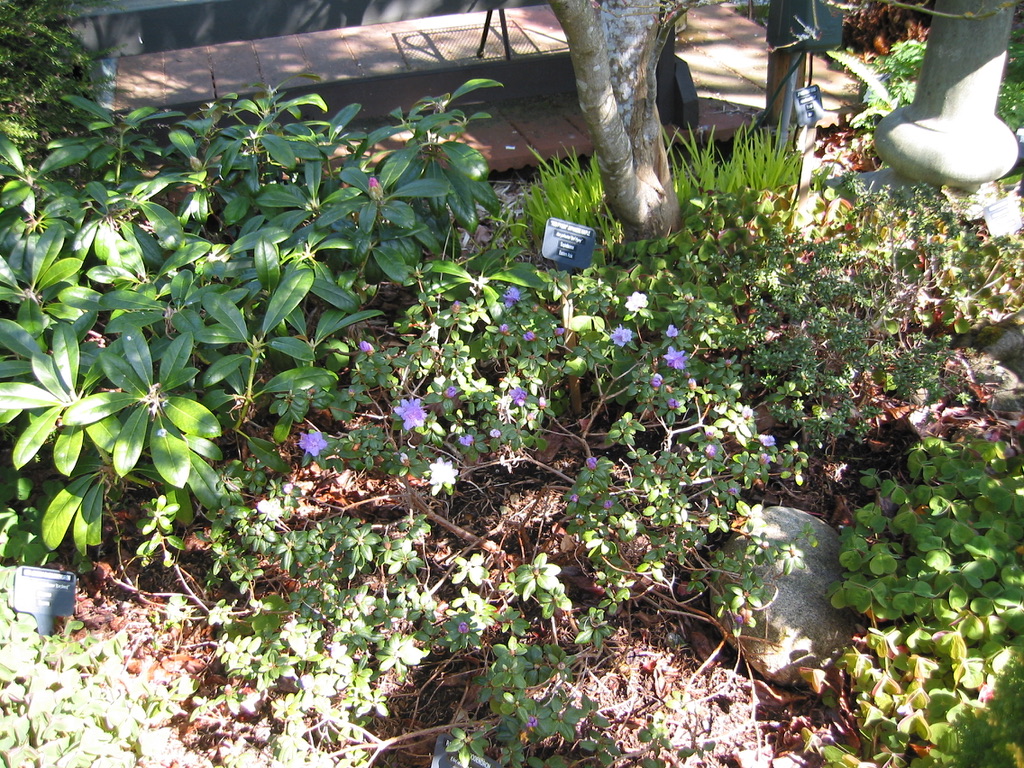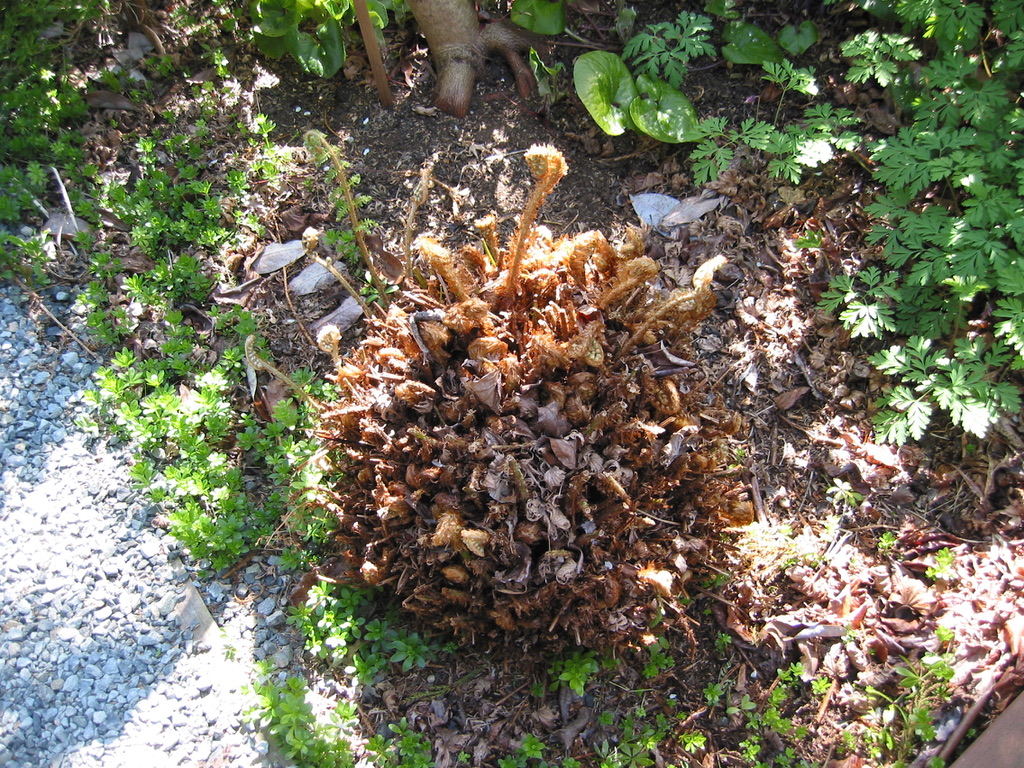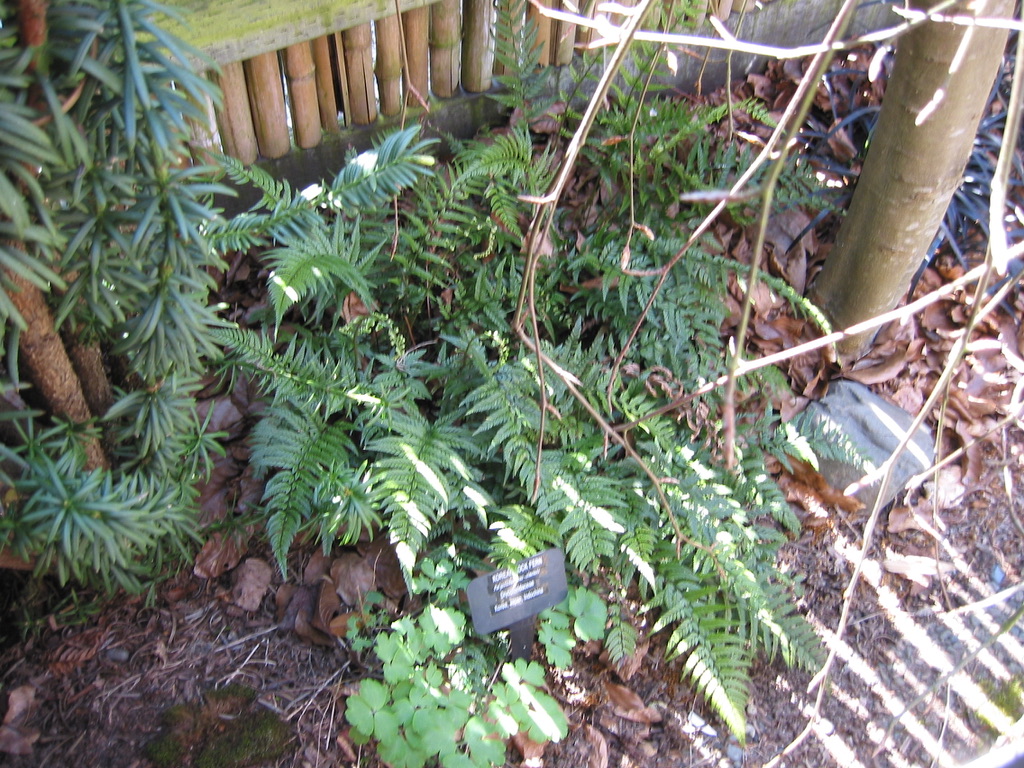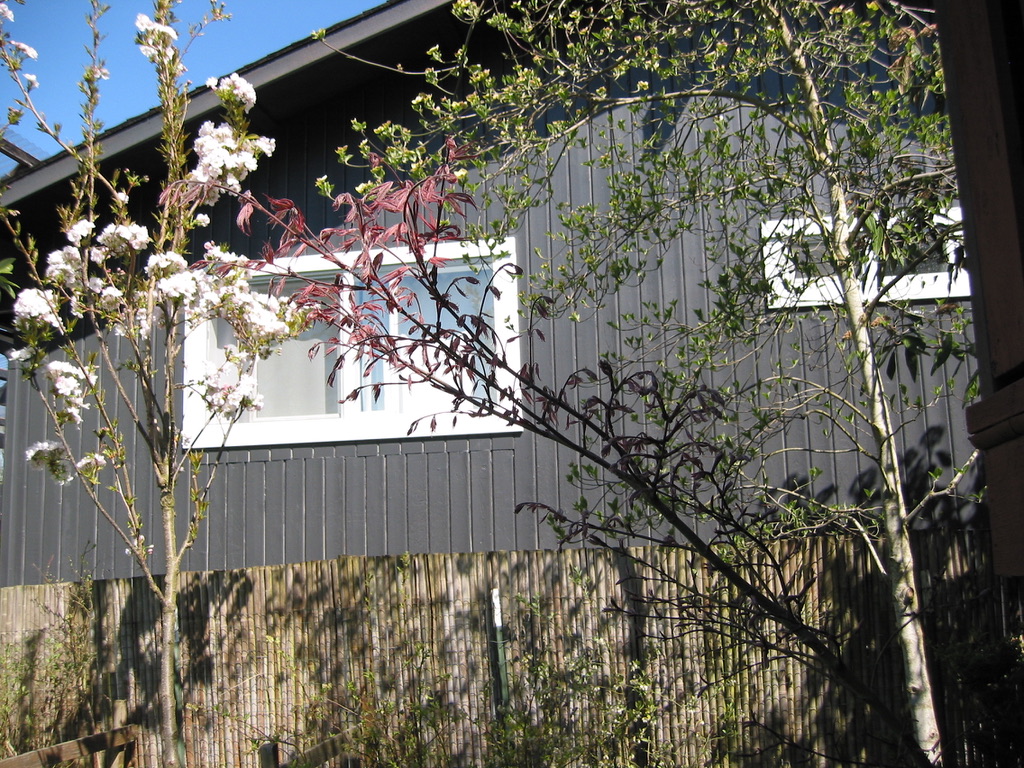
Japanese Tassel Fern (Polystichum polyblepharum)
Spring has sprung and there are many plants that are in their exciting phase of new growth. It’s one of my favorite times of year with all the new buds, flowers and shoots springing forth with such vigor. Things grow fast now and it’s so engrossing to wander thru the garden and check out what’s happening. I take a walk among the plants every morning to see what new wonders have exploded over night. It’s the most dynamic time of year.
I’m going to show you a number of plants as they’re starting out their new cycles of becoming. This first plant is a favorite of mine (aren’t they all?? ;-). This Japanese Tassel Fern can grow 2-3 feet wide. This plant has been here for a few years so it’s that big. I cut the ferns back in early spring every year so the new growth predominates and we get to see the glory of the new growth without the faded old fronds.

Floating Cloud Japanese Maple (Acer palmatum “Ukigumo”)
Look at the top of the tree here. You can see the white new growth of this pale maple. The foliage is white with creamy pink and green borders. It’s a small maple which is good since doesn’t have a lot of room to grow. It’s been here for 10 years now and is still small. Most of the growth has formed down low so it’s very full and luscious when it’s all leafed out. From a distance it sure does look a lot like floating clouds.

Eddie’s White Wonder Dogwood (Cornus florida x nuttallii)
This is a cross between the east and west coast dogwoods and is very vigorous and floriferous. The “flowers” aren’t actually flowers at all. They’re called bracts and are simply masquerading as blooms. This plant will be covered with these “flowers” soon and they’ll get much larger than in the photo. It also shines in fall when the whole tree turns a beautiful scarlet.

Mackino’s Holly Fern (Polystichum mackinoi)
Another lovely fern that is a bit ahead of the others. It has crinkly fronds that are spiny to the touch. It gets 2-3 feet wide and stays evergreen until I cut it back, as do most of the others I’ll show you.

Robust Male Fern (Dryopteris filix-mas “Robusta”)
This one will grow to be about 3 feet across. The fiddleheads are prominent here – almost primeval. If I had more of them I might just pick a few to eat. I used to do that backpacking in the High Sierra years ago. They taste a little like asparagus. But I don’t want to cut them back because they look too cool, and I can buy asparagus at the store.

Hime Shojo Japanese Maple (Acer palmatum “Hime Shojo”)
This is our newest Japanese maple, one of about a dozen we have now. I had a larger growing maple here but I decided to move it before it got too big. This one stays pretty small – under 10 feet, if that. It has bright reddish purple leaves that turn an even deeper burgundy in fall. It contrasts nicely with the white Sir Charles Lemon rhododendron behind it and the red Hino Crimson azalea in front.

Bloodgood Japanese Maple (Acer palmatum “Bloodgood”)
If you look at the tops of this tree you can see the new growth. It’s at least 6-8″ long so far and will hopefully grow a another foot or more. One year it didn’t grow at all and it freaked me out. The nursery said it happens sometimes but I’d never seen it before. Luckily it came back great again the next year. It turns a deep burgundy in fall.

Tomatoes
What collection of new beginnings would be complete without some baby tomatoes? I’ve got 3 heirlooms here: Beam’s Yellow Pear (a small prolific yellow pear that kids eat like candy), Burbank Slicing (an all around yummy from the man that brought us the famous Burbank Potato) and Heirloom Marriage Marzinera (said to be the finest paste tomato you can grow). I started them later than I should have but they’ll still be big enough to plant by Mother’s Day – my usual start date for them. We’ll get tons of tomatoes from them. I have great luck starting these from seed.

Weeping White Spruce (Picea glauca “Pendula”)
You can see lots of new buds bursting forth on this one. I’ve worked hard to get this tree to put on a strong top. The first two years they were only 6″ tall and bent over. I had to train it up straight. Last year it grew 12″ and I’m hoping for a foot and a half this year. So far so good. Supposedly it’ll grow 30 – 40 feet tall.

Ramapo Rhododendron (Rhododendron “Ramapo”)/ Japanese Forest Grass (Hakonechloa macra “All Gold”)
This is one of the earlier Rhododendrons to bloom here. The pale lavender flowers are small but there are lots of them. Under the tree is the Japanese Forest Grass. It dies down in winter so these are the lush new stems.

Soft Shield Fern (Polystichum setiferum)
This is the largest fern we have. It grows well over 4 feet across and is awesome when the fronds are covering it. This clump is about a foot and a half across. In another month it’ll be full and lush. It’s right next to our back deck where it adds a forest like atmosphere.

Korean Rock Fern (Polysichum thus-simemsis)
This may be my favorite fern, tho it’s so hard to say. It’s the only evergreen fern I never touch. It looks beautiful all year round. The new fronds are visible among the old ones and they all look great. This is near the house so we get to see it close-up all the time. It’s growing under a copper beech so it’s always shaded, which it seems to love.

Red Fox Katsura (Cercidiphyllum japonica “Rot Fuchs”)
The new leaves of this tree shine in the morning sun. It grows much taller than it does wide in a sort of column. It’s a form of the Katsura tree which grows much wider than tall. That’d get too big here but this one will fit just fine. It turns a nice apricot in fall and they say the leaves smell like cotton candy, tho I’ve never smelled it. Maybe someday.

Miss Grace Dawn Redwood (Metasequoia glyptostroboides “Miss Grace”)
This is a dwarf form of an ancient tree. It’s only 9 feet tall compared to well over a 150 feet for the species. It’s a redwood that loses its leaves in fall. They come back this lovely green apple green in spring, but the buds are on the tree all winter. It looks like it’s going to burst forth all the time so it’s exciting when it finally does.

Silver Sabre Fern (Polystichum xiphophyllum)
Some call this the “X-fern”, for the species name. Kinda cool I guess. It looks great all year and I always wait till the last moment to cut it back because it looks so good here at the entrance to the front garden. But it’s worth doing it because the new growth is such a beautiful shiny green. New ferns look like there should be dinosaurs around.

Mugo pine (Pinus mugo)
See the new candles on this small pine tree? Once they get a bit longer I’ll break them all in half so the plant stays tight and full. I’ve done it for years and it always comes out great, as you can see. I love how it spills over the wall here. It’s by the front entrance and greets everyone who comes to visit us. The size of these pines varies greatly so I’m not sure how big it’ll eventually get. We’ll see.

Shirazz Japanese Maple (Acer palmatum “Shirazz”)/ Flagpole Flowering Cherry (Prunus serrulata “Amanagowa”)
Two for the price of one here. We originally planted this maple out front but it froze its first year. I’d never heard of a Japanese maple freezing so I was very upset. I dug it up and canned it and it slowly came back. With some creative training it’s now a nice small tree that should grow into a nice specimen. The cherry is just starting to bloom here. The flowers are very fragrant but too high to smell most of them. It turns reds and oranges in fall.

Himalaya Maidenhair Fern (Adiantum venustum)
A hardy evergreen maidenhair fern. I didn’t even know one existed until I saw this in a nursery. A month ago they looked terrible but now the new growth is a light green which will darken into a dark green in another month. It’s growing and spreading under the Miss Grace Metasequoia I showed you earlier. It’s been thriving in its shade.

Leatherleaf Viburnum (Viburnum rhitydophyllum)
These new buds will open soon to become creamy white flowers. It’s a large plant that I’m trying to keep narrow despite it wanting to grow much wider. So far it’s working fine. I love the tropical look to its large leathery leaves.
That’s it. We have so many more choices to share but these were the ones that best showed the things I wanted you to see. I love looking at the ways plants begin to grow. The ferns in particular catch my attention but they all have their attractions. Spring is such a vibrant time of year. I hope you all are enjoying all the new beginnings in your own neighborhood. There’s always so much more to see and appreciate.
Happy New Beginnings!
Steve

















